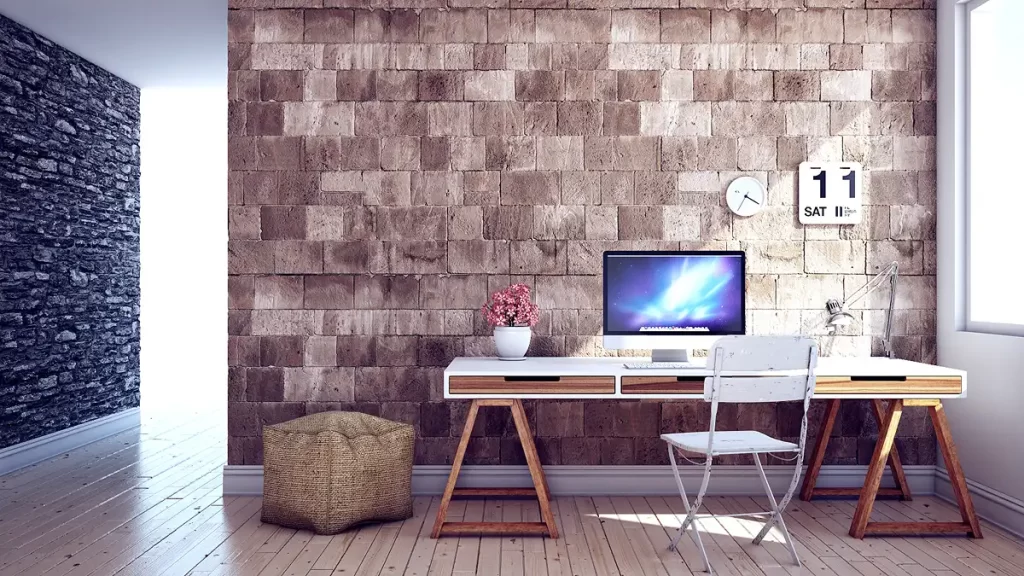Expert suggestions for locating and setting up a successful office at home, including choosing the best room, considering needs, and implementing space-saving strategies.
As we’re writing this, millions of people are self-isolating, either voluntarily or by mandate of their state and local governments.
As business offices close and stay-at-home orders are issued, many of us are scrambling to set up home offices.
Unless you’re lucky enough to have a home that is ready for you to set up a home office, finding the right space for a new home office can be tricky. Most homeowners or renters don’t have a room that’s waiting to be filled with a desk and other office furniture.
If you’re like most people, your home accommodated your lifestyle before life changed with health concerns. Your previous priorities directed how your home’s rooms would be used. Now, however, you have a new priority and it’s a big one. You need to get some work done while keeping your family safe. Adjustments are probably necessary.
You may have already figured out where to put your home office. Sometimes it’s just a matter of locating it the only place it can go.
But, if you have a barely-used den, dining room, or corner in the family room, you may have choices.
This article will help you understand that your first instinct—the one that may have worked perfectly two months ago—may not be your best choice now. The current health crisis has changed many things that now need to be considered.
With this change, you need to strongly consider the relationship of your home office to the people and activities in your home. More specifically, you need to weigh privacy and solitude against awareness of what’s going on in the house.
The more central the location of your home office, the better you’ll be able to keep an eye on the kids or household activities. However, the more central it is, the more noise, distractions, and interruptions you’ll encounter when you’re working. So, the best location will depend upon where you stand on this spectrum.
For example, a corner of the kitchen or family room may once have been the perfect spot to set up your desk. Now, the family spends most of its time in those places. Whether or not that is a good thing will depend upon your particular situation. If you need to be watchful and available to your family, it’s a good thing. If you need quiet and solitude, it definitely is not.
When checking out various possible locations, don’t worry about amenities such as lighting and the reach of your home’s WiFi. If the lighting is poor, you can provide floor or desk lamps. And if the WiFi is out of reach, you can get a WiFi extender or a better router.
Let’s begin by thinking about some rooms or areas that may be less used than others.
Dining room. If your family typically eats in the kitchen or a breakfast room, and you have a dining room that goes unused most of the time, this may be the best location for a home office.
In the current health situation, you probably won’t be using your dining room for entertaining. The dining room, in fact, may be a better choice than a spare bedroom or guest room at this particular time because, if someone in your family does fall ill, you may need that spare bedroom to isolate them.
Also, a dining room is usually easy to convert because, other than the table and chairs, it isn’t typically filled with furniture. In fact, the dining table often makes a great desk or counter.
Spare bedroom. If you’re lucky enough to have a spare bedroom or a den, that may be a good answer if solitude is important. Not only will it be quieter than more central areas, but hopefully it will have natural window light, heating, cooling, and electrical power ready to go.
Just keep this in mind: If your office is in the spare bedroom, be ready to vacate it if someone in your household becomes ill.
Master bedroom. If using part of the master bedroom for an office is your only option, then so be it. But this isn’t an ideal place for a home office in most households.
For one thing, your spouse may not be thrilled if you’re pecking away at your keyboard late at night or early in the morning.
For another thing, if your office is in your bedroom, you can’t get away from your work, even when it’s time to sleep. You probably don’t want to wake up looking at the work you didn’t finish yesterday.
Then again, you might be able to minimize these issues by employing furnishings, such as a folding decorative screen, Shoji panels, a freestanding bookcase between the desk and the bed, or similar furniture.
Shared spaces. If you don’t have an extra room for an office, you’ll need to figure out how to share a space. For example, you might be able to steal enough space for a desk:
- Along one wall of a bedroom
- In a kitchen corner
- In a living room alcove
- At the end of a hallway
- In a corner of a recreation room
- Under the stairs
Just be aware that shared spaces will require give and take.
And, as previously stated, spaces common to the family such as the kitchen or family room may be filled with activity, noise, distraction, and interruptions—especially if your kids are out of school. Then again, you may be grateful to have a central command post like this.
Dividing to conquer. Nothing says that office activities have to happen in one place. If you don’t have enough space to provide for all of your office work in one place, consider dividing up activities and equipment. You could, for example, have a writing desk in one room and set up your computer monitor somewhere else. If you need file cabinets or a copier, maybe they can go in the garage or under the stairs.
This brings up the issue of file cabinets. One really smart improvement you can make is to digitize most of your files. Buy an inexpensive, fast, multi-page scanner (available on Amazon) and convert those cabinets of files into easily accessible digital files that take no space at all. This is a great project to do when you’re hunkered down at home. Store these digital files on a hard drive and on the cloud so that they are backed-up and accessible from home or from your place of business later.
Attic, basement, or garage. In general, think twice before setting up a home office in an unimproved attic, basement, or garage. These types of areas aren’t generally heated or cooled, and they may not have the needed electrical receptacles, etc. They also may not have natural light and other amenities that most rooms have. Of course, if they are improved spaces that have all of the necessary amenities, they may be ideal for your home office.
A little planning will go a long way when setting up a home office. Though this new work space is meant to get you through the health crisis, it may do more. You may fall in love with it and choose to maintain it even after the urgent need subsides.










 Don Vandervort writes or edits every article at HomeTips. Don has:
Don Vandervort writes or edits every article at HomeTips. Don has:



